It was 99 degrees and our AC stopped blowing cold air. Time for another repair! Through the following set of troubleshooting steps I was able to determine the source of the problem–a bad AC condenser fan motor. I went out and was able to buy a replacement motor. I installed it and it ran fine… but then it started blowing the 60-amp circuit breaker. After some help from a very generous HVAC friend I was able to correct the wiring and get it up and running again. Follow along to learn how to troubleshoot an air conditioner and even repair it yourself. I must admit that this is not even nearly an exhaustive troubleshooting guide but hopefully the steps I went though will help many people anyway as it addresses many of the common issues that can cause your AC to fail.
How to Troubleshoot an Air Conditioner
Step 1: Check your furnace filter.
A dirty filter prohibits the proper flow of air through the air conditioner, over-works the fan, and can cause the AC coils to freeze up. The furnace filter will be located on the side of the furnace where the air enters the furnace and will vary in location depending on the installation of your furnace. My featured image above is an example of a way-overdue furnace filter. I’ve seen them worst though–to the point where the filter material was hanging out like a parachute–not good. A dirty filter can cause your furnace to freeze up, places unnecessary burden on the blower motor, and will definitely not run efficiently. You should change your furnace’s filter every 3 months!
Step 2: Check to see if your thermostat battery is low or dead.
Some thermostats require batteries. Even if the LCD display works, the battery voltage may not be sufficient to switch the relay inside the thermostat, which in turn switches on the relay at the condenser unit. I’ve heard of a slightly low being battery the culprit of a non-working furnace. If you have an old-fashioned thermostat, there is likely not a battery in it. Examples of battery-less thermostats include the round dial-style thermostats or this one:
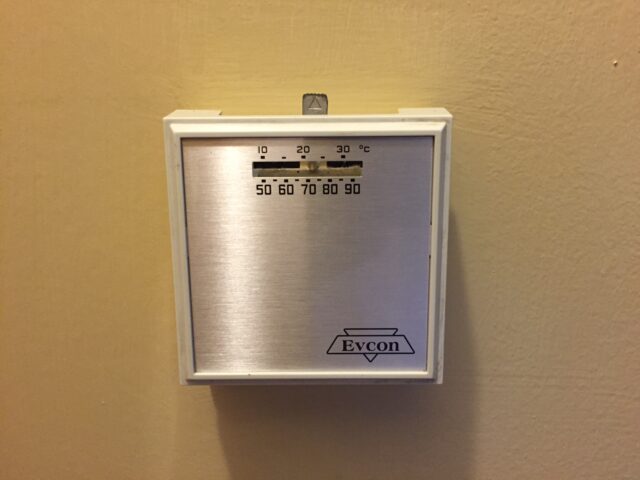
Most programmable thermostats, like this one below, have batteries inside them:

I’ve written multiple articles on thermostats that you may be interested in:
- How to Program a Robertshaw 9615 Thermostat
- How to Program a Ritetemp Model 8050 Thermostat
- How to Program a Honeywell Thermostat Model T8112D1021
- How to Wire an Ecobee Eb-SmartSI-01 Thermostat to a Carrier 58PAV Furnace
Step 3: Check your circuit breaker.
If you have a blown circuit breaker it will definitely keep your AC from coming on. It also can keep your AC from blowing cold air since the condenser circuit breaker can get tripped but the furnace will continue to run and the fan will simply circulate the air in your house. Likely the condenser unit will be high enough amps to have two breakers tied together like this:
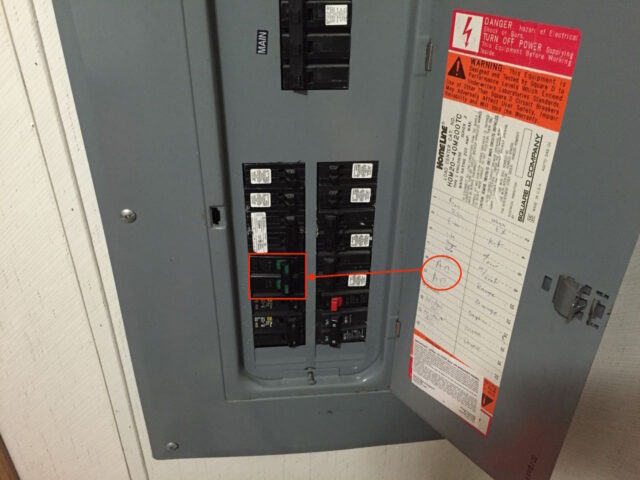
A blown circuit breaker will often be positioned in the middle. To reset it switch it all the way to the off position and then all the way over to the on. A blown circuit breaker may be a sign of something else being wrong (and pulling too many amps) but sometimes the reset of a circuit breaker may be all that you need. In my most recent case, it was the sign of a bad AC condenser fan motor.
Step 5: Your AC condenser coils are dirty.
If you live in an neighborhood with cottonwood trees, your condenser coils could be full of cotton. If the condenser cannot draw air through the coils then your condenser unit cannot cool the freon, which is necessary. Use a hose and spray the condenser coils clean. The coils are very fragile so don’t scrape them with anything because you will bend the fins. You can wash off the fins while the condenser is running. I wouldn’t spray the electrical conduit, etc, while you are doing it though.
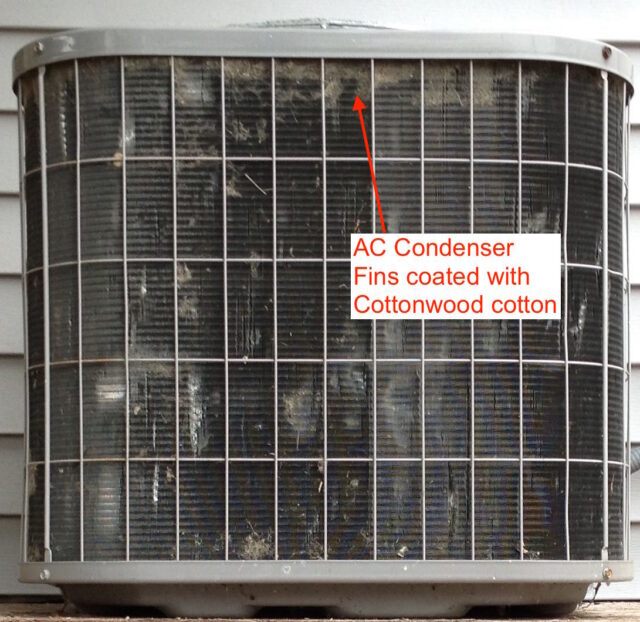
Step 5: Check to see if your condenser unit is coming on.
The compressor is the big metal box sitting just outside your house. You should see an insulated copper line running to it, and also a flexible electrical conduit connected to it as well. It has a big fan in the middle of it. Here was the AC compressor from my last house:
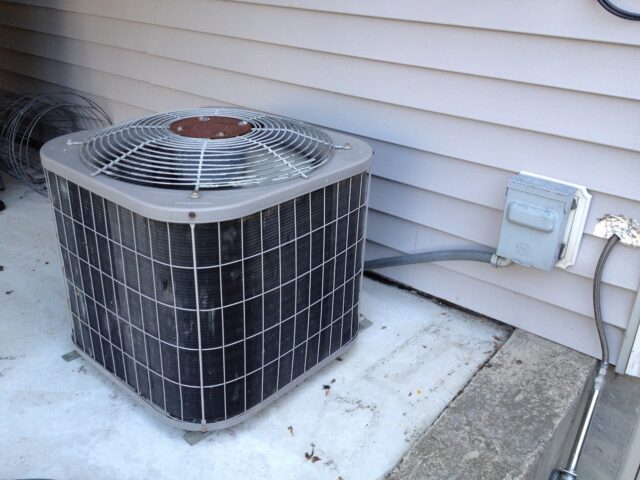
The fan should come on and the compressor too. The fan will be obvious and the compressor may or may not be able to be heard, but it will sound just like your refrigerator running (because your refrigerator has a compressor in it too!). Some options as to what you might find if there is something wrong with your AC condenser unit:
Condenser Symptom 1: The condenser is clicking or buzzing but the fan does not come on.
This could be a bad relay (or also called a “contactor”), which is the electromagnetic switch, which makes the connection between the condenser and the 220-Volt power. One symptom of a bad contactor is that you will hear a buzzing sound inside the condenser whenever the AC system tries turning it on. I haven’t yet had to replace a relay in my AC condenser, but if I do, I’ll be writing all about it. Here’s what a relay/contactor looks like:
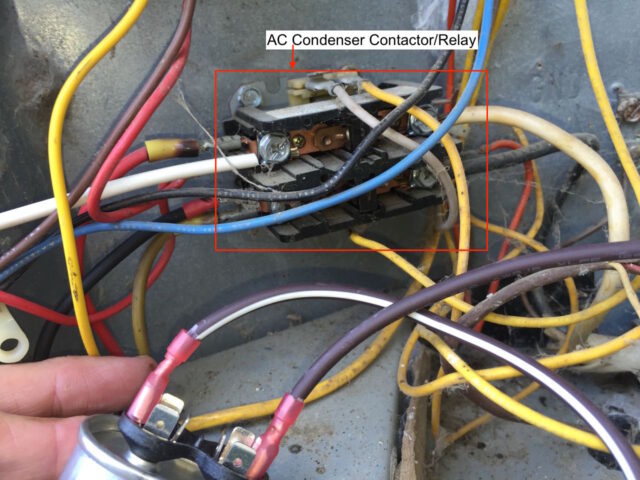
Here is the contactor on my previous house:

These contactors are mechanical devices that physically connect the electrical power to the motor and compressor and they do wear out over time.
Condenser Symptom 2: The compressor is running but the fan is not running.
This was the situation for me this time–I could hear the compressor inside running but the fan was not running. There are multiple things that could be the source of this problem: a bad relay, a bad starter capacitor, or a bad motor. The fact that the compressor was coming on showed me that it wasn’t a relay because the same relay (an electro-mechanical switch) powers both the compressor and the fan. I tried starting the fan manually by inserting a long screwdriver through the grill and (carefully) spinning the fan blades, but the fan would not start. This told me it wasn’t the starter capacitor. If it was the starter capacitor, then the fan would start up with a little help. I wrote an article on changing a condenser unit starter capacitor (an easy thing to do) in this article:
How to Replace the Starter Capacitor on an AC Condenser Unit
This is what my condenser unit was doing when it had a bad starter capacitor:
If the fan will not start even with a little help from your screw driver, then you may have a bad fan motor. I had more evidence that my fan was bad because the circuit breaker kept tripping as well (along with the hint I got earlier when I saw the fan off but the condenser still going–a sign pointing to the fan). If you have determined that your fan is the culprit, then read the following article where I go through the process of replacing my AC condenser fan motor:
How to Replace an AC Condenser Fan Motor
Condenser Symptom 3: The fan is running but the compressor is not running.
This would be worst since you’ll probably need an HVAC professional to handle that issue. I won’t go into this issue, yet… who knows what will happen in the future 🙂
Did this article help you fix your AC? Do you have a tip to add? Please leave a comment!
Hopefully these troubleshooting steps have helped you move closer to solving your AC problem. Leave a comment if you have a question or feedback and I’ll get right back with you. Also, comments of successful repairs encourage others to do their own repairs. Thanks!
Please note: if you do not have any approved comments on this site then your comment must be personally approved by me before it will appear. I do this to keep my site 100% free of spam comments. I read them all and almost always review and respond to all comments within a day. I look forward to hearing from you.
Amazon Associate Disclosure: As an Amazon Associate I earn from qualifying purchases. This means if you click on an affiliate link and purchase the item, I will receive an affiliate commission. The price of the item is the same whether it is an affiliate link or not. Regardless, I only recommend products or services I believe will add value to Share Your Repair readers. By using the affiliate links, you are helping support Share Your Repair, and I genuinely appreciate your support.


